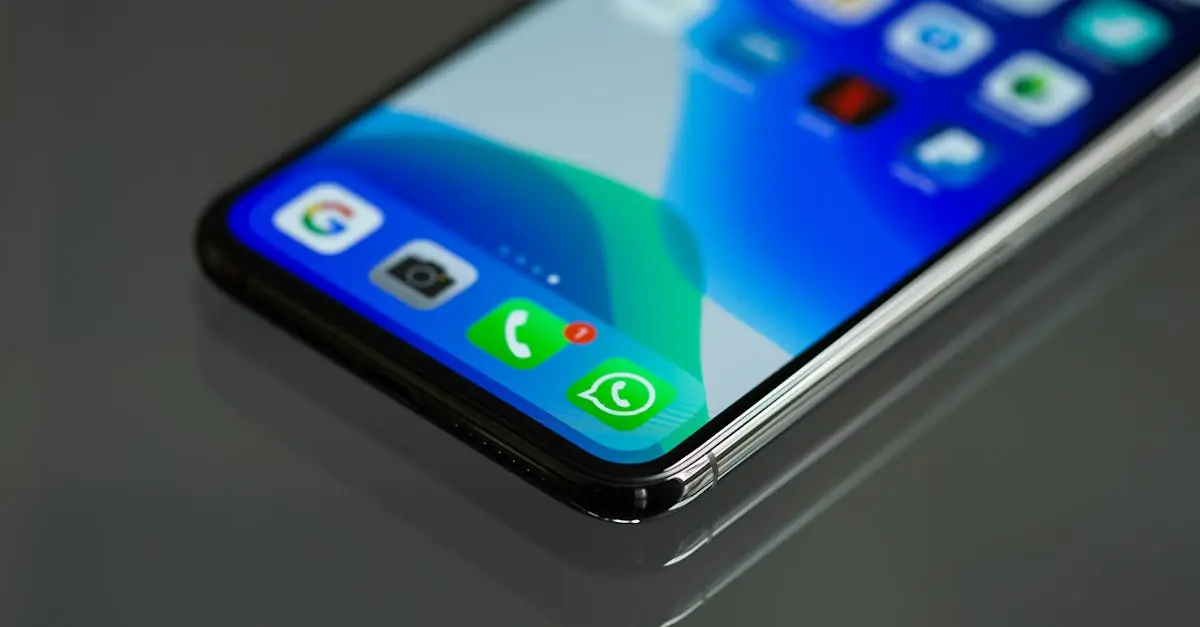Ever wondered what those little red circles on your iPhone notifications are all about? They’re not just for decoration; they’re badges, and they’re here to help you stay organized in the chaotic world of apps. Think of them as your digital cheerleaders, waving their pom-poms to let you know there’s something you really shouldn’t ignore—like that message from your best friend or a reminder about your dentist appointment.
Table of Contents
ToggleUnderstanding Badges on iPhone Notifications
Badges on iPhone notifications appear as small red circles with numbers. These numbers indicate the count of pending notifications for specific apps. Users often find badges beneficial for staying updated on messages, missed calls, or reminders.
Each installed app can display a badge when there’s new content or required attention. For instance, an email app will show the number of unread emails, while messaging apps highlight unread messages. Customization options exist, enabling users to choose which apps display badges.
Managing badge notifications occurs in the iPhone’s settings. Users can enable or disable badges for apps according to individual preferences. This feature enhances the organization of notifications, filtering through unimportant alerts.
Some users may feel overwhelmed by too many notifications. Badges offer a quick visual reference, helping prioritize which tasks to address first. When a user clears notifications, the badge updates instantly, providing real-time feedback.
App developers also utilize badges to enhance user engagement. Users often respond more favorably to applications that remind them of recent activity. Badges encourage users to interact with app content, fostering better communication between the app and its user.
Badges on iPhone notifications serve a crucial role in user experience. They facilitate timely responses and help manage daily tasks effectively. Users can leverage this feature to streamline their digital communications.
Purpose of Badges
Badges on iPhone notifications serve essential functions, providing immediate insights into app activity. These small red circles help users prioritize their tasks and manage information efficiently.
Visual Indicators
Badges act as visual cues, signaling the number of pending notifications for each app. Each red circle contains a number that indicates unread messages, missed calls, or notifications requiring attention. Users quickly discern which apps demand immediate action by glancing at these indicators. The clarity offered by badges enhances organization, allowing users to track important updates at a glance. Clear visual indicators help manage digital communication, ensuring timely responses and effective time management.
User Engagement
Engaging users effectively is another key purpose of badges. When apps display badges, they attract users’ attention, encouraging them to return and interact with the application. Users are more likely to open apps with unread notifications due to the visual reminder. This interaction leads to heightened engagement and app usage. Developers leverage this strategy to improve user retention, knowing that consistent reminders keep users involved. Through badges, developers cultivate a proactive user experience, enhancing overall satisfaction with the app’s functionality.
How Badges Work
Badges on iPhone notifications provide a quick visual reference for users. They inform about the status of messages and tasks, making it easier to manage communications.
Notification Count
Each badge displays a number that represents pending notifications. For instance, if there are three unread emails, the badge shows the number three. This visual aid helps users prioritize attention based on importance. Users can easily gauge which apps require immediate action, streamlining their workflow. Notifications disappear once addressed, causing the badge count to update in real-time. This functionality ensures that users stay informed without the constant need to check apps. The badge count reflects urgency, assisting users in making efficient decisions throughout their day.
App-Specific Functionality
Apps utilize badges uniquely, tailoring notifications to user preferences. Different applications may indicate distinct types of notifications, such as unread messages or missed calls. For example, a messaging app might display a badge for unread messages, while a social media app could show notifications for interactions. Users can customize badge settings, selecting which apps display notifications. This personalization enhances the user experience, allowing individuals to prioritize notifications that matter most. Developers design badges to keep users engaged, signaling when new content is available. Each app benefits from this functionality, leading to increased interaction and user retention.
Customizing Badge Settings
Users can easily adjust badge settings to enhance their experience. This customization allows control over which apps show badges and how they appear.
Enabling/Disabling Badges
To enable or disable badges for apps, users navigate to the iPhone settings. Access the Notification settings, then select the specific app. Within this menu, users find the option for “Badge App Icon.” Switching it on or off determines whether the app displays a badge. If notifications become overwhelming, turning off badge notifications can declutter the home screen.
Managing App Notifications
Managing app notifications allows fine-tuning of how users receive alerts. In the Notification settings, users can modify alerts for each app. Options include sounds, vibrations, and a preview of messages. Select an app, and tap to customize preferences. Prioritizing notifications ensures that important alerts get attention while minimizing distractions from less critical updates.
Badges on iPhone notifications play a crucial role in helping users manage their digital lives. They provide a straightforward way to visualize pending tasks and important messages. By customizing badge settings, users can tailor their notification experience to prioritize what truly matters, reducing clutter and distractions.
These small red circles not only enhance organization but also encourage engagement with apps. With real-time updates reflecting the status of notifications, badges ensure that users stay informed and responsive. Ultimately, badges serve as an effective tool for streamlining communication and improving time management in today’s fast-paced world.



